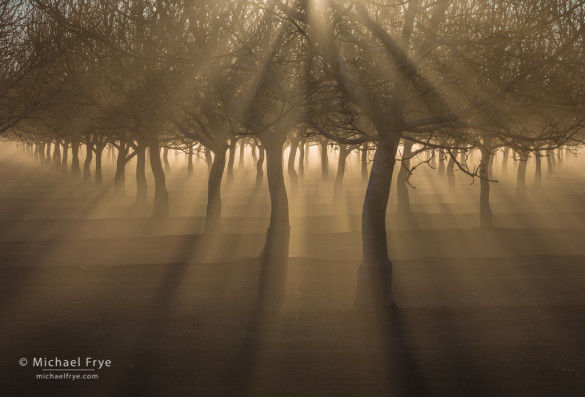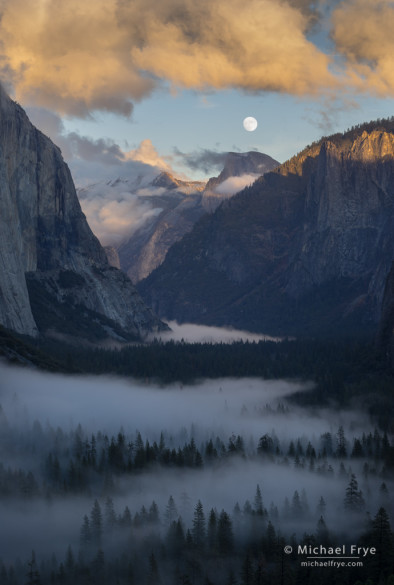I’m pleased to announce that once again The Ansel Adams Gallery is sponsoring a special print sale of two of my photographs, at 25% off the normal price. The two images we selected for this offer are Orchard With Sunbeams and Fog, Sacramento Valley, California, and Moon Rising Above the Valley, Yosemite National Park. These two photographs have never been exhibited at a gallery or sold before, although, as many of you know, both of these images were voted by my readers to be included in my best images of 2014, and the Orchard With Sunbeams and Fog photograph was the top vote-getter.
My signed, limited-edition 16×20 prints usually sell for $325, but during this sale you can get one for only $244. Or you can purchase a 20×24 print, normally $475, for only $356. This is a rare chance to purchase one of my photographs at a reduced price, but the sale lasts for just six days, until Sunday, March 22nd, at 6:00 PM Pacific time. Visit the Ansel Adams Gallery website to purchase a print or get more details.
Here are the stories behind the photographs:
Orchard With Sunbeams and Fog, Sacramento Valley, California (shown above)
One January morning, while driving an obscure little road in the Sacramento Valley, my wife Claudia and I stumbled upon an orchard filled with fog. As far as we could tell there was no other fog within 50 miles, because it was a drought year, and there was very little moisture anywhere. But for some reason this one spot had fog – possibly because the trees had been watered recently, creating enough moisture to condense into fog in the cool morning air.
Seeing the sunbeams cutting through the mist underneath the trees, I grabbed my camera and tripod, and quickly framed a few compositions, trying, as much as possible, to separate each trunk visually from its neighbors. This composition is my favorite. Within five minutes the fog had burned off, leaving us with yet another clear, warm, dry January day.
Moon Rising Above the Valley, Yosemite National Park
In winter the full moon rises further to the north than at other times of year, aligning with the angle of Yosemite Valley, and with Half Dome. On this particular December evening, I calculated that the moon would rise directly above Half Dome from Tunnel View – a unique opportunity.
The only problem was that I had been drafted as a guest juror for the Yosemite Renaissance exhibit, and the second (and final) judging meeting was set to take place that same evening. There was a thick cloud cover that afternoon, which threatened to obscure the moonrise, so I thought perhaps there wouldn’t be a conflict after all. But when we took a break from the meeting at around 3:45 p.m., I stepped outside, and the weather looked more interesting. The clouds were breaking up, with shafts of light reaching the cliffs. Even if the moon didn’t appear it looked like a promising sunset. Um, sorry folks, gotta go!
When I arrived at Tunnel View there were a lot of clouds around Half Dome. Gradually, however, the clouds started to dissipate. Then the edge of the moon appeared right above Half Dome. Soon the entire moon came into view, in a great position, with the clouds and misty valley floor adding to the mood of the scene.
After sunset I returned to the meeting. I was gone less than an hour, and I think they hardly missed me. I’m glad I played hooky for that hour!
Click here to purchase one of these prints. And please feel free to ask me questions, either by posting a comment below, or sending me an email. As always, thanks for your support!
— Michael Frye
Related Post: My Top Photographs of 2014
Michael Frye is a professional photographer specializing in landscapes and nature. He is the author or principal photographer of The Photographer’s Guide to Yosemite, Yosemite Meditations, Yosemite Meditations for Women, Yosemite Meditations for Adventurers, and Digital Landscape Photography: In the Footsteps of Ansel Adams and the Great Masters. He has also written three eBooks: Light & Land: Landscapes in the Digital Darkroom, Exposure for Outdoor Photography, and Landscapes in Lightroom 5: The Essential Step-by-Step Guide. Michael has written numerous magazine articles on the art and technique of photography, and his images have been published in over thirty countries around the world. Michael has lived either in or near Yosemite National Park since 1983, currently residing just outside the park in Mariposa, California.











Michael…My question involves the use of a camera profile every start of processing an image. Is this basically using pre-defined settings to start or doing something else to the image you can’t acomplish manually in Lightroom? I love your book “Landscapes in LR5”. Can’t wait for another book from you to read. Maybe something about workflow in the field?? Also, what do you think of the new Lightroom 6? I appreciate your help in this profile question and look forward to your reply. Have a great day….
Thomas Abbott
Thomas, I’m glad you like the ebook, and I appreciate the kind words. The effects of changing the camera profile can be duplicated, sort of, sometimes, with other tools in Lightroom, but not as easily, and not as well. Some profiles, for example, have more or less contrast than the default Adobe Standard profile, and that look can be pretty easily duplicated by adjusting Whites, Black, or Contrast. But the way different profiles render different color hues is not as easily duplicated by pushing sliders around in the Develop Module. Sometimes you can do it that way, but sometimes you can’t. The profile is fundamental – it’s actually the first step in translating the Raw data that the camera captures into the tones and colors you see on your monitor. Because of that, it’s often easier to start by looking at the profile, and choosing one that renders the colors the way you’d like, than to try to fix the colors by some other means.